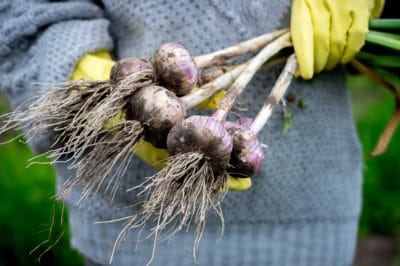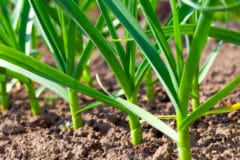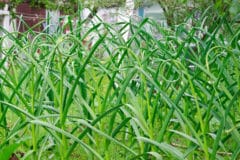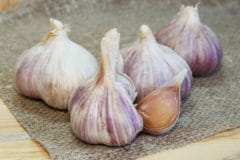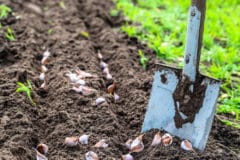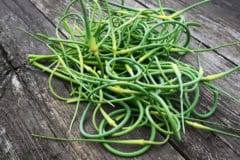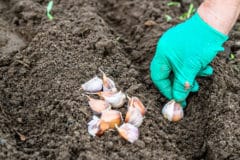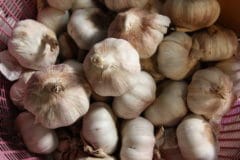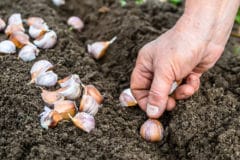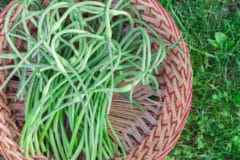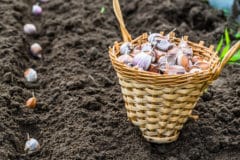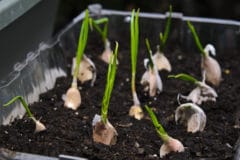Softneck vs. Hardneck Garlic
Garlic is available in two types: softneck and hardneck. The first has multiple leaves that grow together much as the stems of a leek or onion do. The second has a hard central flower stalk. Softneck garlics are like the kind you get at the grocery; they are usually grown mostly in areas with moderate weather. Hardneck garlic is hardier and has fewer but larger cloves.
Good Garlic Varieties
Expect these to be ready to harvest in 90 days if spring planted, about 240 days if fall planted:
- California Early – softneck, typical grocery store variety.
- Carpathian – hardneck from Poland.
- Siskiyou Purple – softneck, good for hot climates.
- Georgian Red – hardneck, large cloves, stores well.
- New York White – softneck, also known as Polish White.
- Spanish Roja – hardneck, easily peeled.
- Chinese Red and White – hardneck, strong flavor.
Fertilizing Garlic for A Good Harvest
Fertilizing practices definitely affect harvest time and the size of the cloves. Garlic is a heavy feeder and needs more nitrogen than you might expect. Use aged manure or well-rotted leaf mold to prepare the soil ahead of planting. Fertilize every three or four weeks with seaweed or fish emulsion. Once the cloves start to form, use low-nitrogen fertilizer. Too much nitrogen at that point can make cloves split.
Watering Garlic for A Good Harvest
Water makes a difference in garlic’s flavor and storage qualities. While garlic doesn’t like really wet soil, it does prefer a constant supply of moisture. Water whenever the top inch of soil seems dry and water deeply. Once the leaves start to turn brown near the bottom of the plant, stop watering. Watering at this point can cause rot or split bulbs.
Fall-Planted Garlic
In temperate climates – especially those with warm winters – garlic is usually planted in the fall. Harvest time will depend on when the cloves were planted, the expected maturity date and the weather. It’s important to recognize that fall-planted garlic doesn’t really grow during the winter; it sends up shoots in spring. Maturity dates are calculated from this point. Fall-planted garlic may take 240 days altogether.
Spring-Planted Garlic
Spring-planted garlic doesn’t usually see as much variation in the weather as fall-planted garlic. Nor does it have the long dormant period through the winter. Maturity dates are usually a reasonably good guide to harvest time. If you plant in February, you may be able to harvest in June. Garlic is generally hardy, so even late freezes don’t usually cause problems.
Harvesting by Leaf Condition
As cloves begin to come to maturity, the leaves of the garlic plant will begin to dry and turn brownish. Generally speaking, the ideal harvest time is when half the leaves have dried up and half are still green. If you need to harvest the whole crop at once, wait until most of your plants have reached this half-and-half stage. You can also harvest individual plants as they are ready.
Scapes and Harvest
Garlic scapes are the immature flowers on the central stalk of hardneck garlic. Softneck garlics rarely produce scapes. The scapes can be harvested and used in the same way as cloves. Actually the operative words are “should be harvested.” Cutting off scapes helps the plant concentrate on clove formation rather than flowering. Scapes are also an indication the garlic is only a few weeks from harvest.
Weather and Harvest
In humid climates or areas with late spring rains, weather plays a part in harvesting. Try to harvest when you will have some consistently dry days. Garlic must be cured before it can be stored, and this takes about three or four weeks of drying in an airy, well-ventilated area out of direct sun. The ideal place is hung from a post or line in the shade with some light breezes.
How to Harvest Garlic
Garlic is actually a flowering plant that we dig rather than pick. This “stinking rose” must be lifted from the ground with hands or a garden fork. If you pull it by hand, make sure you have a grip on the bulb so the stem doesn’t break. Growing it in loose, friable soil that drains well is good for the garlic and also makes it easier to harvest.
